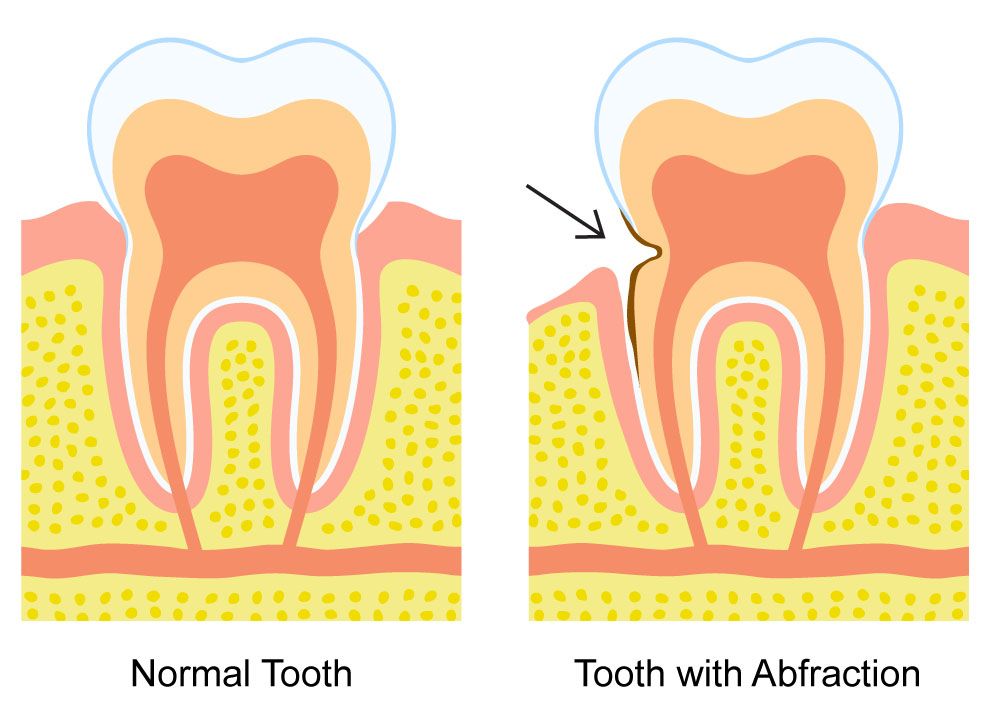A Notch Above…the Gum Line: Dental Abfractions
 While the term “dental abfraction” may not necessarily be familiar to you, the condition itself may be. If you have teeth with portions that have been notched out at the gum line, then you have what are clinically known as dental abfractions. It was once believed that people could prevent abfractions from becoming worse simply by changing their tooth brushing habits. However, it is now known that abfractions will only increase if restorative dentistry treatments are not performed.
While the term “dental abfraction” may not necessarily be familiar to you, the condition itself may be. If you have teeth with portions that have been notched out at the gum line, then you have what are clinically known as dental abfractions. It was once believed that people could prevent abfractions from becoming worse simply by changing their tooth brushing habits. However, it is now known that abfractions will only increase if restorative dentistry treatments are not performed.
In discussing dental damage and abfraction during consultations at his Staten Island, NY cosmetic, restorative, and general dentistry practice, Dr. Joseph T. Mormino acquaints patients with their treatment options and helps them determine which is best suited to their particular cases. He also explains to them why it is so important to treat dental abfraction in a timely manner and not allow the problem to worsen.
If you have noticeable notches in your teeth at the gum line, we urge you to schedule your initial consultation with Dr. Joseph T. Mormino today.
What Are Abfractions and How Are They Caused?
It is important to note that abfractions are not caused by tooth decay. Unlike tooth decay, bacteria are not the cause of abfraction, although exposure to bacteria can cause an abfraction to worsen over time. It was once thought that the primary cause for abfraction was improper tooth brushing. Again, while over-aggressive tooth brushing can certainly cause abfractions to become worse (in addition to causing other dental problems), it is generally not the cause of abfractions.
The two most common causes of abfractions are:
- Bruxism: More commonly known as tooth grinding, chronic bruxism exerts unnecessary pressure on the teeth. Over time, this can lead to the breakdown of the enamel and cementum that protect the teeth above and beneath the gum line, respectively. As these protective substances are damaged, notches can form in the underlying dentin at the border of the gums.
- Malocclusion: Otherwise known as a “bad” or faulty bite, malocclusion refers to the failure of the upper and lower teeth to meet properly when the jaw is closed. Like bruxism, malocclusion can place undue pressure on the teeth, particularly while chewing. This, in turn, can cause abfractions to form as the result of enamel and cementum breakdown at the gum line.
If left untreated, abfractions can grow in size, allowing bacteria greater access to the delicate dentin layer of the teeth. Over time, this will lead to root canal infections and eventual tooth loss. However, Dr. Mormino can treat abfractions, whether minor, severe, or in between, with restorative dentistry. Treatments such as tooth-colored fillings and dental crowns can be used to restore and protect the teeth from further damage. At the same time, he can recommend therapies for bruxism or malocclusion to address the underlying cause of abfractions.
Learn More about Dental Damage and Abfractions
To learn more about dental damage and abfractions, or to schedule your initial consultation with Dr. Joseph T. Mormino, please contact our restorative dentistry practice today.


